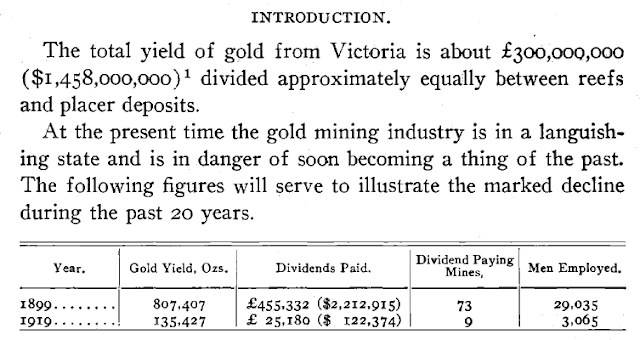Gold was discovered in Clunes in the vicinity of Ballarat in 1850 by James Esmond. It is not coincidental that the discovery was made two years after the discovery of gold in California. Esmond had been a miner and prospector in the recently discovered California gold fields.
This was followed in 1851 by the discovery of very rich gold deposits at Ballarat by James Regan and John Dunlop.
The Ballarat, Bendigo, Clunes, Walhalla and other gold fields of Victoria, Australia have had production of 77 million troy ounces (2,400 metric tonnes) of gold. This production total is largely for the first period of mining from 1850 until the early1920's.
An excerpt from Junner's 1921 Economic Geology paper shows the decline in production from 1899 to 1919. In 1899, there were 29,035 men employed. His paper is worth reading since it was written when there was still access to the underground mines.
 |
| Junner's table. |
Ballarat has also yielded some of the largest gold nuggets of the world. New discoveries of large gold nuggets still continues to this day, thanks to the popularity of metal detectors. A 145-troy ounce nugget was found in 2016 and a 112-troy ounce nugget was found around Ballarat in 2014.
 |
| Replica of the "Welcome" nugget. Photo by R.A. Kirkham at a museum in Vienna, Austria. |
 |
| Sketch of the "Welcome Stranger" from the Discovery Channel Australia. |
 |
| The "Latrobe" Nugget. |
Source: Discovery Channel-Australia, Website
The Ballarat District has three types of gold deposits: 1) Orogenic quartz veins (called "Quartz Reefs") hosted by Ordovician turbidites now slates and intrusive rocks including dikes with ladder veins 2) Paleoplacers (Oligocene to Miocene) called "Deep Leads" in the district; these are buried placers overlain by volcanic rocks or younger sediments, and 3) "Shallow Leads" which are placer deposits exposed at the surface.
 |
| Historic map of the Ballarat District, showing the leads in yellow following ancient channels. |
Source: Finlay, I.S., Douglas, P.M., 1992. Ballarat 1:100,000 mines and deep leads map geological report. Geological Survey of Victoria Report 94. Ballarat Geological Report
The origin of the large nuggets has been an enigma. A paper by Hughes and others suggest that the origin may be secondary enrichment and growth during deep weathering during the Cenozoic. During this time several periods of tropical weathering occurred including the development of laterites, saprolites and kaolinite. The depth of the water table also varied significantly over this time. Evidence for supergene gold enrichment was identified by Junner in 1921.
The evidence:
- Variations in gold-silver ratios in alluvial deposits and supergene zone of primary deposits.
- Coarsening of gold in the weathering zone.
- Colloform, arborescent and botryoidal gold textures.
- Abundant perfectly crystallized gold in alluvial deposits and in the weather zone of primary deposits.
- An abundance of gold nuggets in some deeply weathered areas.
- Gold concentration in fossil trees and possibly diagenetic pyrite.
 |
| They are still finding big nuggets in Ballarat! |
Selected References:
Hughes and others, 1998, Lateritic weathering and secondary gold in the Victorian Province [Australia]
Link to Hughes
Junner, N.R., 1921, The geology of the gold occurrences of Victoria, Australia, Economic Geology, vol. 16, p.79-123.


